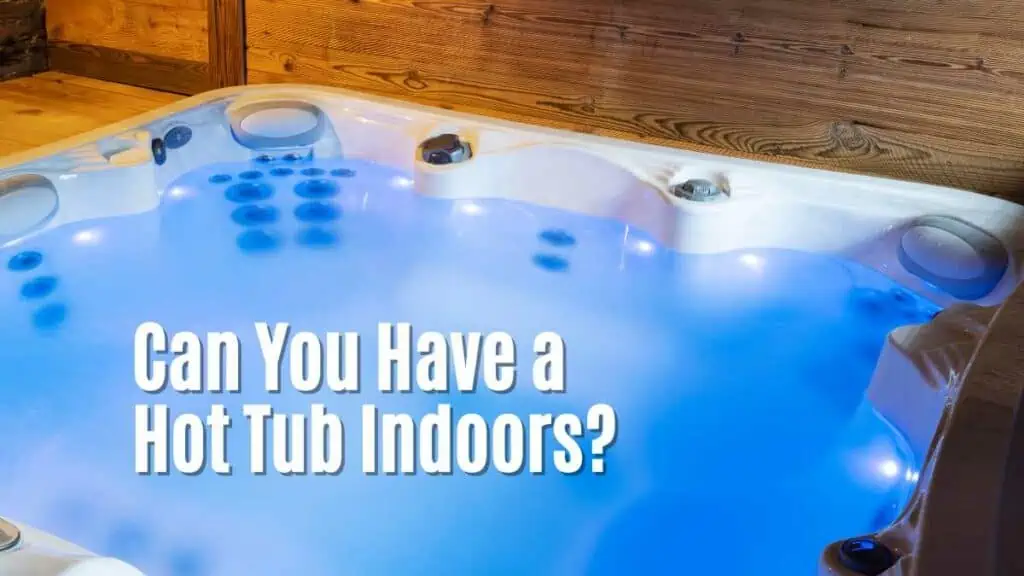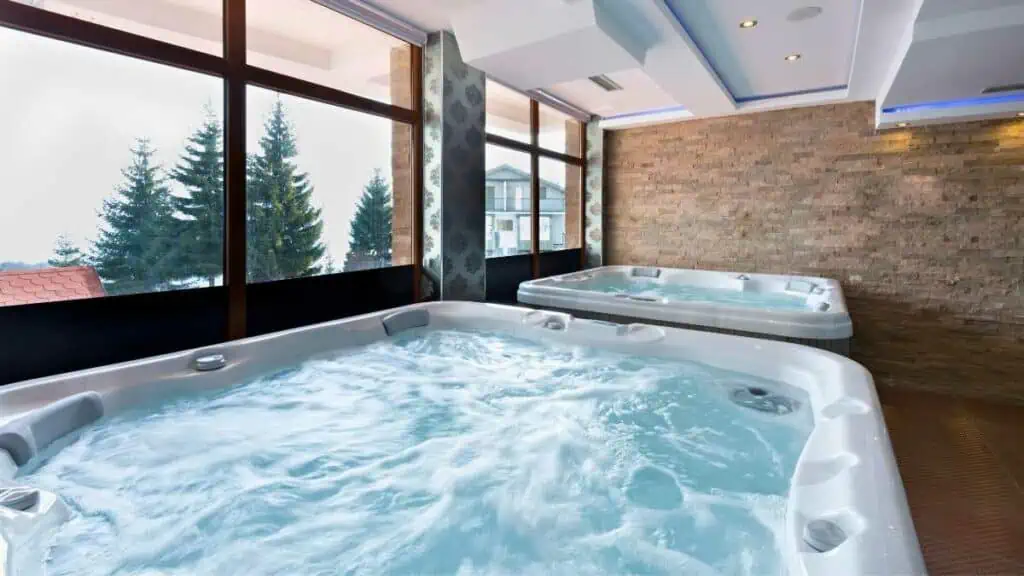Picture this: it’s a cold, frosty evening, and the outside world is dark. As the temperature drops, you yearn for the ultimate relaxation experience. Now, imagine stepping into your very own indoor hot tub right in the comfort of your home. The soothing warmth envelops you, and the day’s stress begins to melt away.
No wonder indoor hot tubs are increasingly popular for homeowners looking to create the perfect relaxation space.
They provide a convenient, year-round option for hydrotherapy, unwinding after a long day, and spending quality time with friends and family. With a wide range of styles, sizes, and features, indoor hot tubs are available to suit everyone’s needs and preferences.
While an outdoor hot tub often requires meticulous planning, an indoor hot tub can usually be easily incorporated into existing rooms or new home additions.
However, many factors, such as ventilation, structural support, and surrounding materials, still need to be considered when planning and installing an indoor hot tub. By carefully considering these aspects, you can create an inviting and rejuvenating indoor hot tub experience tailored to your home and lifestyle.

Key Takeaways
- An indoor hot tub offers year-round relaxation and hydrotherapy benefits
- Proper planning is essential to install and maintain an indoor hot tub effectively
- Enhancing your indoor hot tub experience can be achieved through customization and thoughtful design
Understanding Indoor Hot Tubs
Can You Have a Hot Tub Indoors?
It is perfectly feasible to have a hot tub indoors; however, there are some important considerations to remember.
These include ensuring that your floor can handle the weight of the indoor hot tub, that you will have adequate ventilation to prevent the buildup of hot, moist air, which can lead to mold and other issues and whether you can get the hot tub indoors through doors etc.
Indoor hot tubs offer a relaxing and soothing place to unwind no matter what the weather is like outside.
My Experience: When we lived in the UK, my wife and I had our first hot tub indoors in a new conservatory extension to our house, and we experienced no problems at all. If we had sited it outdoors, we would have rarely used it in the winter and probably not as much in the summer.
Although sitting in a hot tub on a cold, clear night has its attractions, it rains an awful lot in the UK, so who in their right mind would want to sit in a hot tub in the pouring rain?
Indoor vs Outdoor Hot Tubs
While both indoor and outdoor hot tubs serve the same purpose – providing relaxation and enjoyment – there are some differences you should consider when choosing between the two:
- Location: Indoor hot tubs require a dedicated space inside your home, with a sturdy support structure and ventilation. On the other hand, outdoor hot tubs can be placed anywhere in your backyard, providing enough space and a level surface.
- Weather: With an indoor hot tub, you don’t have to worry about the elements as much, and you can enjoy your spa experience year-round. Outdoor hot tubs may require more maintenance depending on the climate, such as winterizing the tub and protecting it from harsh weather.
- Privacy: Indoor hot tubs generally provide more privacy as they’re located within your home. To ensure privacy, outdoor hot tubs may require additional measures, like fences or screens.
- Installation and maintenance: Indoor and outdoor hot tubs require regular maintenance, including cleaning and water treatment. However, indoor hot tubs may require additional steps, such as ensuring proper ventilation and humidity control, to prevent damage to your home.
Benefits of an Indoor Hot Tub
An indoor hot tub brings many benefits to your life, including:
- Relaxation: Soaking in a hot tub can help relieve stress, ease muscle tension, and promote relaxation, making it a perfect addition to your self-care routine.
- Entertainment: Indoor hot tubs can serve as a unique entertainment feature, allowing you to host spa parties and intimate gatherings or simply enjoy quality time with your loved ones.
- Therapeutic benefits: Spending time in an indoor hot tub can help improve circulation, decrease joint pain, and alleviate symptoms like arthritis and fibromyalgia.
- Convenience: An indoor hot tub allows you to enjoy the benefits of a spa experience without leaving the comfort of your own home.
When considering an indoor hot tub, evaluate your available space, budget, and overall needs to ensure you make the right choice for your lifestyle. Enjoy the transformative power of an indoor hot tub for your relaxation and well-being.
Planning for an Indoor Hot Tub

Analyzing the Space
Before installing an indoor hot tub, evaluating your available space is important.
Room Dimensions: You should consider the room’s size, unused space, and overall layout. It’s crucial that your chosen area can accommodate not only the hot tub’s dimensions but also provide adequate space for you and your guests to move around comfortably.
Access: You also need to consider access to the room where you install the hot tub. Hot tubs are not small items and will not normally go through standard-width doors. So you may need to remodel, perhaps remove a window or make other alterations to get the hot tub inside.
What is under the floor? You should ensure that the area under the floor where you intend to site the hot tub does not have any sewage/drainage pipes running through it. The weight of a full hot tub could cause the pipes to collapse.
When our conservatory was built, a drain pipe was in the area where the hot tub would sit, so we had to relocate it to avoid this.
Ventilation: You will also need adequate ventilation, particularly when the hot tub cover is off. I found that as long as I opened a few windows when using the hot tub, I had no condensation problems.
Plumbing/drainage: A hot tub doesn’t need to be plumbed in as it is a stand-alone unit. You just need to be able to run a hose to fill it and empty it with a submersible pump.
If you’re living in an apartment or have a home with multiple floors, you should also ensure that your structure can support the additional weight from the spa. Consult a structural engineer to verify that the floor can hold the hot tub’s weight, which may range from 40-100 lbs per square foot.
Note: You should check with your homeowner’s insurance that you can have a hot tub indoors without invalidating your cover.
Choosing the Right Model
When selecting a hot tub model for your indoor installation, consider your needs and the room’s size. The number of possible locations in many homes is generally quite small; there is only one logical location in many cases.
Smaller and mid-sized hot tubs are typically more manageable for indoor use, as they have a lower water volume and may be easier to maneuver through doors and around corners. You can also consult the hot tub’s specifications to ensure it can be safely installed indoors.
Consider the most desired features, such as seating capacity, jets, and lighting options. By carefully considering these factors, you can find the perfect model for your space and preferences.
Installation of an Indoor Hot Tub
Prepare the Foundation
When installing an indoor hot tub, preparing the foundation is important. Make sure you have a sturdy floor that can support the hot tub’s weight, which can be around 700 pounds, plus an additional 2,502 pounds for 300 gallons of water.
You might need to reinforce your flooring or consult a structural engineer to ensure your floor is strong enough.
Drains and Plumbing
A hot tub is self-contained, so it does not need to be connected to a water supply or drainage system.
I always filled mine with a hose pipe, and when I needed to empty to clean the hot tub, I either used a submersible pump attached to a hose and fed the water outside or, as my rear yard sloped away from the house, I used a hose and, creating a siphon, I let gravity do its work.
Read: 4 ways to drain a hot tub
Indoor Hot Tub Ventilation
Adequate ventilation is crucial for maintaining indoor air quality and preventing mold or mildew growth. As I stated above, I never had any problems with excess moisture. I just opened a few windows using the hot tub, which worked perfectly.
However, in your particular situation, you may need to install an exhaust fan or an HVAC (heating, ventilation, and air conditioning) system specifically designed to handle the humidity your hot tub generates.
Ensure the ventilation system works effectively and maintains a comfortable environment to enjoy your hot tub.
Enhancing Your Indoor Hot Tub Experience
Hot Tub Cover
A hot tub cover and a hot tub cover lifter are essential accessories for your indoor hot tub.
Although you won’t get as much debris and contaminants entering the water as you might with an outdoor hot tub, a hot tub cover will still give two main benefits:
- Help to maintain the water temperature, reducing energy costs.
- Reduce the amount of condensation as water vapor will condense on the underside of the cover and drop back into the hot tub.
When choosing a hot tub cover, look for one with a good insulation rating to maximize its efficiency. Some covers even have built-in safety features, such as locking straps, giving you peace of mind while protecting your investment.
Creating a Relaxing Atmosphere
Creating a relaxing environment is essential to fully enjoying your indoor hot tub’s benefits. Here are some tips to help you do that:
- Aromatherapy: To soothe, add essential oils or scented spa crystals to the water. Popular choices include lavender, eucalyptus, and chamomile.
- Music: Soft, soothing music can enhance relaxation, so consider installing a waterproof sound system or Bluetooth speakers in the hot tub area.
- Mood lighting: To make the space more relaxing, make sure you have nice lighting in the room that you can control, perhaps with different colors.
- Towels and robes: Keep plush, comfortable towels and robes nearby for added comfort after your soak.
Remember, the key to a relaxing indoor hot tub experience is creating an ambiance that allows you to unwind and fully enjoy the benefits of your jacuzzi.
Hot Tub Maintenance Course
I bought Swim University’s Hot Tub Maintenance Course a while after I bought my first hot tub and struggled to maintain it. It was very well spent and has paid for itself many times over the years as I have saved by not needing to use as many chemicals as I did previously.
Listen to our Hot Tub Course Review Podcast:
Summary
Certain factors must be considered when choosing between outdoor and indoor hot tubs. While outdoor hot tubs provide a unique experience of relaxation in the midst of nature, indoor hot tubs offer the advantages of privacy and year-round usability.
If you opt for an indoor hot tub installation, you may wonder, “Can you put a hot tub indoors?” The answer is yes, with the proper planning and structural considerations. An indoor hot tub not only offers convenience but also allows for easy access regardless of the weather conditions. Whether you choose an indoor or outdoor hot tub, the primary goal is to create a serene and rejuvenating space for yourself.
Indoor Hot Tub FAQs
Can I put a hot tub on any floor indoors?
No, you need to ensure that the floor can support the weight of the hot tub, which can be quite heavy when filled with water. A sturdy floor, such as a concrete slab, is recommended.
Do I need to have a special room for my indoor hot tub?
Not necessarily, but you should have a well-ventilated space to prevent hot, moist air buildup. It’s also important to have enough room for easy access and maintenance.
How do I prevent water damage to my indoor hot tub area?
Proper preparation is key, including having a drainage system in place to prevent water damage to your flooring and walls. You can also protect your flooring with a waterproofing membrane.
Can I use any hot tub indoors?
Choosing a suitable hot tub for indoor use is important, as some models may not be designed for this purpose. Look for models with built-in ventilation systems designed for use in enclosed spaces.
Are there any special safety considerations for indoor hot tubs?
Yes, it’s important to ensure that your hot tub is installed in compliance with local building codes and safety regulations. You should also install a GFCI (ground fault circuit interrupter) to prevent electrical shocks.






Leave a Reply